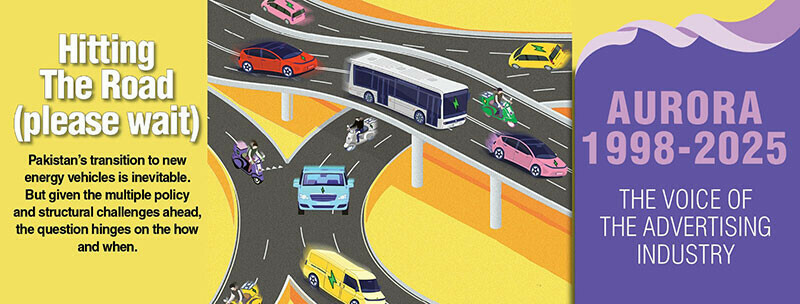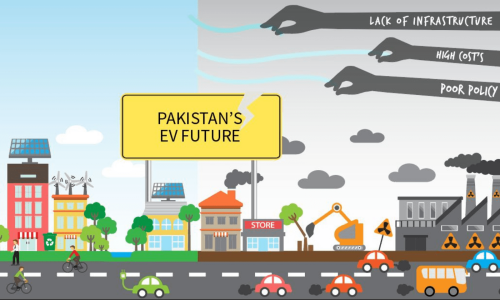Just Saying: Hitting the Road (please wait)

Pakistani consumers are enthusiastic, but not necessarily early adopters. If something appears that makes sense to them economically and improves their lifestyles, they are likely, after due consideration, to adopt it. What is currently happening with solar panels is proof of this, if any is needed.
The same enthusiasm will apply to new energy vehicles – eventually. New energy vehicles – hybrid, electric and even biogas-run (see our interview with Hiroshi Kawamura, MD, Pak Suzuki) – are a very good thing. Good for the environment and good for the pocket. Furthermore, given the inadequacies of public transport systems, the demand for cars surges as soon as the macroeconomic conditions improve. In fact, according to data posted by the Pakistan Automotive Manufacturers Association, car sales rose by 38% to 112,203 units in FY 2025 compared to 81,579 units last year.
There are, however, significant concerns in terms of EVs; the charging infrastructure, long-term battery life, affordability and resale value. For manufacturers, the concern is scale – particularly cars. Scale, because only when sales start to move the needle can investments become a viability. At the heart of these concerns lies the inconsistency in government policies and whether they are indeed implementable. Pakistan is littered with policies that have failed because they are often drafted without considering the ground realities and robust stakeholder buy-in. The 2019 Auto Policy has come and gone without achieving much, and there are misgivings that the new policy too may fall by the wayside. As it stands, the new policy has been divided into three phases: building the infrastructure, supporting manufacturers, followed by a full-scale transition from 2035. Missing is the implementation roadmap. This said, there is definite interest (and some investment) from manufacturers in both the two- and four-wheeler segments. No one doubts that the transition to new energy vehicles is inevitable, and everyone believes it is desirable. But how and when this will happen, no one can say for certain. In the meantime, Pakistani consumers are sensibly adopting a wait-and-see policy.
With this issue, Aurora will be taking a pause. Disruption has finally caught up with the magazine; as eyeballs migrate online, so do advertisers. Aurora had favoured print because it prioritises a large-format design and display. But times have changed, and the hope is that eventually Aurora will resurface with a strong online presence.
For the Aurora teams (present and former) who gave each successive edition their dedication and passion, this is a sad moment. Part of the joys of working on Aurora is the support we consistently receive from the advertising and marketing communities, particularly in the form of their contributions to the magazine. When Aurora appeared in 1998, coverage about advertising, marketing, and brands was a rare occurrence, except for a few dense articles in academic journals. Aurora changed this, and we are both immensely grateful for, and proud of, this. From the get-go, senior and experienced professionals across the spectrum of the advertising, marketing and media functions lent their support to Aurora and demonstrated an exceptional (totally unexpected and warmly welcomed) willingness to contribute their ideas and opinions to the magazine. In turn, their example encouraged young people in the industry to put forth their ideas and insights, creating the unique mix of opinions that we see in Aurora’s pages today. This is what has kept the magazine relevant, engaging and alive right up to this edition – and what makes Aurora the authentic voice of this industry. A big shout-out to every single one of our contributors; Aurora is as much a product of your support as it has been the team’s. Thank you.
To our readers, you have kept Aurora on track for 27 years with your presence and support. From a niche magazine with the remit to cover advertising, marketing and the media, our readers today are drawn from an increasingly wide cross-section of occupations and interests; start-up entrepreneurs, economists, policymakers, academics, students and thought leaders. We are overwhelmed and grateful for your time and attention, and we are particularly proud that our pages have found resonance across generations, from Boomers to Gen Zers.
Twenty-seven years is a long time, especially in today’s time-compressed world. Looking back at our coverage, it is quite amazing to see the change that has taken place and the pace of it. A cliché, but a reality too. The magazine’s coverage has been vast, not only in opinion and commentary, but hard stats and data – which will be available in our archives online.
A final word. In a recent interview, Mark Zuckerberg spoke about Meta’s ability to use AI and eliminate the need for creatives, marketers and agencies. Instead, businesses would be able to connect their bank accounts to Meta, and their AI would then handle everything from creating ads and videos to audience targeting and performance analysis. How this will unravel in the future remains to be seen. But for sure, had Aurora’s special annual edition been published later this year, the question we would have asked our Talking Heads would have been: “In light of Zuckerberg’s statement, what is your response?”




Comments (0)